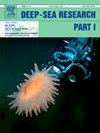Creepy-Crawlies of the Arctic deep sea: Metazoan meiobenthic communities across latitudinal and bathymetric gradients in the western Arctic Ocean
IF 2.1
3区 地球科学
Q2 OCEANOGRAPHY
Deep-Sea Research Part I-Oceanographic Research Papers
Pub Date : 2025-05-02
DOI:10.1016/j.dsr.2025.104513
引用次数: 0
Abstract
Knowledge on meiofauna in the Arctic Ocean is lacking despite their importance for ecosystem functioning. The Synoptic Arctic Survey aimed to fill such knowledge gaps and thus included meiofaunal sampling. A bathymetric transect (from shelf to central basins) was sampled in the western Arctic Ocean during the HLY2202 expedition. Four sampled transect stations were investigated to answer three key questions: (1) How does the meiofaunal community change along the transect? (2) Which sedimentary parameters drive the meiofaunal community compositions? (3) Has the meiofaunal community at the North Pole changed since 1996, and if so, how? The uppermost 3 cm of sediment were analyzed for metazoan meiofaunal composition (including meiofaunal abundance and nematode biomass) in relation to food proxies (i.e. bacterial abundance and biomass, organic carbon, phospholipids, chlorophyll a, phaeophytin) and sediment porosity. Meiofaunal density and taxa count decreased with increasing water and sediment depth, as did nematode body sizes. This supported the concept of deep-sea miniaturization. Thicker nematodes dominated near-surface sediments, while slimmer individuals dominated deeper layers, a pattern related to sediment porosity. Sediment pigments (i.e. chlorophyll) and bacteria were confirmed as important food sources, and sediment porosity was corroborated as an important driver of meiofaunal communities. Virtually no differences were found in abundance of higher meiofauna taxa at the North Pole between 1996 and 2022, potentially due to relative stability provided by the still permanent ice-cover. Examining the meiofaunal composition at genus level will allow analysis of potential changes in diversity and ecosystem functions in relation to environmental changes.
北极深海的爬行动物:北冰洋西部横跨纬度和水深梯度的后生中新底世群落
尽管北冰洋的小型动物群对生态系统的功能很重要,但它们的知识仍然缺乏。《北极综合调查》旨在填补这类知识空白,因此包括了小型动物抽样。在HLY2202考察期间,在北冰洋西部取样了一个测深样带(从陆架到中央盆地)。调查了4个样带站点,回答了3个关键问题:(1)样带沿线的群落特征如何变化?(2)哪些沉积参数驱动了小型动物群落组成?(3)自1996年以来,北极的小型动物群落是否发生了变化?如果发生了变化,是如何发生的?分析沉积物最上层3 cm的后生动物减量生物组成(包括减量生物丰度和线虫生物量)与食物指标(细菌丰度和生物量、有机碳、磷脂、叶绿素a、褐藻素)和沉积物孔隙度的关系。随着水和沉积物深度的增加,小虫密度和类群数量减少,线虫的体型也随之减小。这支持了深海小型化的概念。较厚的线虫在近表层沉积物中占主导地位,而较细的线虫在较深层沉积物中占主导地位,这种模式与沉积物孔隙度有关。沉积物色素(如叶绿素)和细菌是重要的食物来源,沉积物孔隙度是小动物群落的重要驱动因素。1996年至2022年期间,北极高级动物类群的数量几乎没有变化,这可能是由于仍然永久的冰盖提供了相对的稳定性。在属水平上检查小动物组成将有助于分析与环境变化有关的多样性和生态系统功能的潜在变化。
本文章由计算机程序翻译,如有差异,请以英文原文为准。
求助全文
约1分钟内获得全文
求助全文
来源期刊
CiteScore
4.60
自引率
4.20%
发文量
144
审稿时长
18.3 weeks
期刊介绍:
Deep-Sea Research Part I: Oceanographic Research Papers is devoted to the publication of the results of original scientific research, including theoretical work of evident oceanographic applicability; and the solution of instrumental or methodological problems with evidence of successful use. The journal is distinguished by its interdisciplinary nature and its breadth, covering the geological, physical, chemical and biological aspects of the ocean and its boundaries with the sea floor and the atmosphere. In addition to regular "Research Papers" and "Instruments and Methods" papers, briefer communications may be published as "Notes". Supplemental matter, such as extensive data tables or graphs and multimedia content, may be published as electronic appendices.

 求助内容:
求助内容: 应助结果提醒方式:
应助结果提醒方式:


